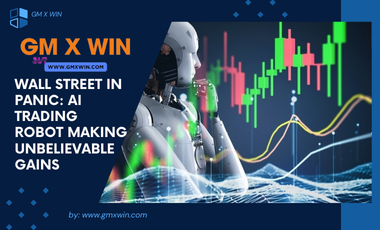The financial world is no stranger to disruption. Over the years, advancements in technology, changes in regulations, and shifts in market dynamics have continuously reshaped the landscape of Wall Street. The latest and perhaps most disruptive force is the rise of artificial intelligence (AI) in trading. Recently, a particular AI trading robot has made headlines by achieving unbelievable gains, sending shockwaves through the financial industry. This article delves deep into the phenomenon, exploring the technology behind AI trading, its implications for Wall Street, and the broader economic and regulatory landscape.
The Evolution of AI in Trading
Early Beginnings
AI in trading is not an entirely new concept. The roots can be traced back to the late 20th century when computer-based trading systems began to emerge. Early systems relied on basic algorithms and were primarily used for executing trades more efficiently.
Rise of Algorithmic Trading
The 2000s saw a significant increase in algorithmic trading, where complex algorithms were used to make trading decisions at speeds and frequencies far beyond human capability. This era marked the beginning of high-frequency trading (HFT), where milliseconds could make a difference in profitability.
Introduction of Machine Learning
The integration of machine learning (ML) into trading marked a significant leap forward. Unlike traditional algorithms, ML models can learn and adapt from historical data, improving their performance over time. This advancement laid the groundwork for more sophisticated AI trading systems.
The AI Trading Robot Phenomenon
The Unbelievable Gains
The recent AI trading robot causing panic on Wall Street has demonstrated gains that are unprecedented. Reports indicate that this AI has consistently outperformed human traders and other algorithmic systems, achieving returns that many believed were unattainable.
How It Works
This AI trading robot utilizes a combination of advanced ML techniques, natural language processing (NLP), and big data analytics. It analyzes vast amounts of data, including market trends, news articles, social media sentiment, and historical trading patterns. By doing so, it can identify trading opportunities with a high degree of accuracy and execute trades at lightning speed.
Key Features
- Predictive Analytics: The AI uses predictive models to forecast market movements.
- Real-Time Data Processing: It processes real-time data to make instantaneous decisions.
- Self-Learning: The AI continuously learns from its successes and failures, refining its strategies.
- Risk Management: Advanced risk management protocols are built into the system to minimize losses.
Implications for Wall Street
Disruption of Traditional Trading
The success of this AI trading robot has disrupted traditional trading practices. Human traders, who once relied on experience and intuition, find themselves outmatched by the speed and accuracy of AI. This shift has led to a reevaluation of trading strategies and a growing reliance on technology.
Impact on Hedge Funds and Investment Firms
Hedge funds and investment firms are feeling the pressure to adopt AI technology to remain competitive. Those that fail to do so risk falling behind, as AI-driven funds demonstrate superior performance and attract more investors.
Job Displacement
The rise of AI in trading has sparked concerns about job displacement. As AI systems become more prevalent, the demand for human traders may decline, leading to potential job losses in the industry. However, new roles in AI development, maintenance, and oversight could emerge, offsetting some of these losses.
Ethical and Regulatory Concerns
The use of AI in trading raises ethical and regulatory concerns. Issues such as market manipulation, transparency, and accountability come to the forefront. Regulators must address these challenges to ensure a fair and stable financial market.
Technological Foundations
Machine Learning Algorithms
At the heart of AI trading systems are ML algorithms. These algorithms can process and analyze large datasets to identify patterns and make predictions. Common ML techniques used in trading include:
- Supervised Learning: Training models on labeled data to predict outcomes.
- Unsupervised Learning: Identifying hidden patterns in unlabeled data.
- Reinforcement Learning: Training models to make decisions based on rewards and penalties.
Natural Language Processing
NLP allows AI systems to analyze and interpret human language. In trading, NLP is used to process news articles, earnings reports, and social media posts to gauge market sentiment and predict stock movements.
Big Data Analytics
AI trading systems rely on big data analytics to process and analyze vast amounts of data. This capability enables them to make informed decisions based on comprehensive market insights.
Cloud Computing
Cloud computing provides the computational power and storage necessary for AI trading systems to function. It allows for the real-time processing of large datasets and the execution of complex algorithms.
Case Studies
Case Study 1: AlphaTech AI Fund
AlphaTech AI Fund is one of the first hedge funds to fully integrate AI trading systems. The fund has achieved remarkable success, consistently outperforming the market. Key to their success is their AI’s ability to analyze market trends and execute trades with precision.
Case Study 2: Quantum Trading Solutions
Quantum Trading Solutions developed an AI trading robot that focuses on high-frequency trading. By leveraging AI and ML, the robot executes trades at microsecond intervals, capturing market inefficiencies and generating significant returns.
Case Study 3: NexGen Investment Partners
NexGen Investment Partners adopted AI technology to enhance their trading strategies. Their AI system analyzes macroeconomic indicators, geopolitical events, and market sentiment to make informed investment decisions, resulting in impressive gains.
The Future of AI Trading
Continued Advancement
AI technology is expected to continue advancing, further enhancing the capabilities of trading systems. Improvements in ML algorithms, data processing, and computational power will enable even more sophisticated AI trading solutions.
Integration with Blockchain
The integration of AI with blockchain technology could revolutionize trading. Blockchain offers transparency, security, and efficiency, which, when combined with AI, can create a robust and trustworthy trading environment.
Expansion to Other Markets
While AI trading has primarily focused on equities, its application is expanding to other markets, including commodities, currencies, and derivatives. This diversification will open new opportunities for AI-driven trading.
Ethical and Responsible AI
As AI becomes more prevalent in trading, there will be a growing emphasis on ethical and responsible AI. Ensuring fairness, transparency, and accountability will be crucial to maintaining trust in AI systems.
Regulatory Landscape
Current Regulations
Regulatory bodies, such as the Securities and Exchange Commission (SEC) and the Commodity Futures Trading Commission (CFTC), oversee AI trading practices. Existing regulations address issues such as market manipulation, transparency, and risk management.
Future Regulatory Developments
As AI technology evolves, regulators will need to adapt. Future regulatory developments may include:
- AI Transparency: Requiring firms to disclose the use of AI in trading and provide transparency into their algorithms.
- Ethical Standards: Establishing ethical standards for AI development and deployment in trading.
- Risk Management: Implementing stricter risk management protocols for AI-driven trading.
Strategies for Businesses and Investors
Embracing AI Technology
Businesses and investors should embrace AI technology to stay competitive. Investing in AI development and integrating AI into trading strategies can enhance performance and profitability.
Continuous Learning and Adaptation
AI technology is continuously evolving. Businesses and investors must stay informed about the latest advancements and adapt their strategies accordingly.
Collaboration with AI Experts
Collaboration with AI experts can provide valuable insights and expertise. Partnering with AI firms and hiring AI specialists can enhance the development and implementation of AI trading systems.
Ethical Considerations
Businesses and investors should consider the ethical implications of AI in trading. Adopting responsible AI practices can enhance trust and reputation in the market.
Conclusion
The rise of AI trading robots and their unbelievable gains are reshaping Wall Street. The integration of advanced ML algorithms, NLP, and big data analytics has enabled AI systems to outperform traditional trading methods. While this technological revolution presents significant opportunities, it also poses challenges and risks that must be addressed. By embracing AI technology, staying informed, and considering ethical implications, businesses and investors can navigate this new landscape and capitalize on the potential of AI in trading.



